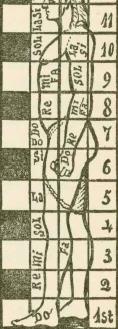HISTORIC GROWTH OF MAN.
SYSTEMATIC CULTURE. 133
THE PRACTICAL WORKING of a
twelve-fold scale of measures and weights shows great advantages over a scale with ten for a basis, like the metric system. The properties of numbers are fixed in the nature of things. We cannot change these properties. The best that we can do is to make our system of numbers and our scale of measures as nearly as possible like these properties in nature.
Nature has used twelve as a basis
of construction in both the head and the body of man. And this twelve
she divides into a series of threes and fours. Even in the hand, where five appears, yet one of these, the thumb, is of entirely different rank from the rest. If the thumb were ranged as one of a row with the fingers, then the hand would have lost all its power and value as an instrument of skill. The five branches of the hand require a sixth part, the palm, as their constant pivot of action.
In all the objects of nature and in the works of man, the constitutent factors of twelve appear seven times as often as the factors :)f ten. These are conclusive proofs of the superior value of twelve as the scale-basis of arithmetic. Jf course, in adopting the series of twelves, we would require a new set of characters or digits to express the numbers. The author proposes to take tie twelve consonant characters of the new alphabet for these figures.
Thirty-five years since, the present writer devised
a system of arithmetic with twelve as its number basis. The subject is of so much practical importance, arithmetic must always have so prominent a part in education, that he has thought it best to give a little space to the subject here. The tables of weights and measures here given can be learned five times as quickly as those of the metric or of the still older systems. And all the practical operations of arithmetic would be shortened.
When a new universal language is adopted, the names applied to the series of numbers in counting will be both simple and regular, so that learning to count will be much easier than with the present method.
MEASURES Or TIME already
have twelve as a prominent factor. But in counting the
hours of the day on dials of clocks and watches, the European nations adopted a method at once unnatural, foolish and wasteful. They began counting the hours of
each day at midnight.
The revolution of the earth on its axis results in twelve hours of daylight and twelve hours of nightshadow, as shown in the upper figure. This is the natural or normal division of a complete diurnal period. But the common and unnatural method takes the shadow period, divides it into two halves, and gives one half to one day and one half to another day ! This is shown in the lower figure. Here we see that Thursday consists of one period of light and two half periods of darkness. Surely an ill-balanced brain conceived such a mode of division.
'1
-NDRMAI M141slOT(
'Chursdag-TIl ay-Saturday
Day
Aft
2Lnna1ural. Division.
